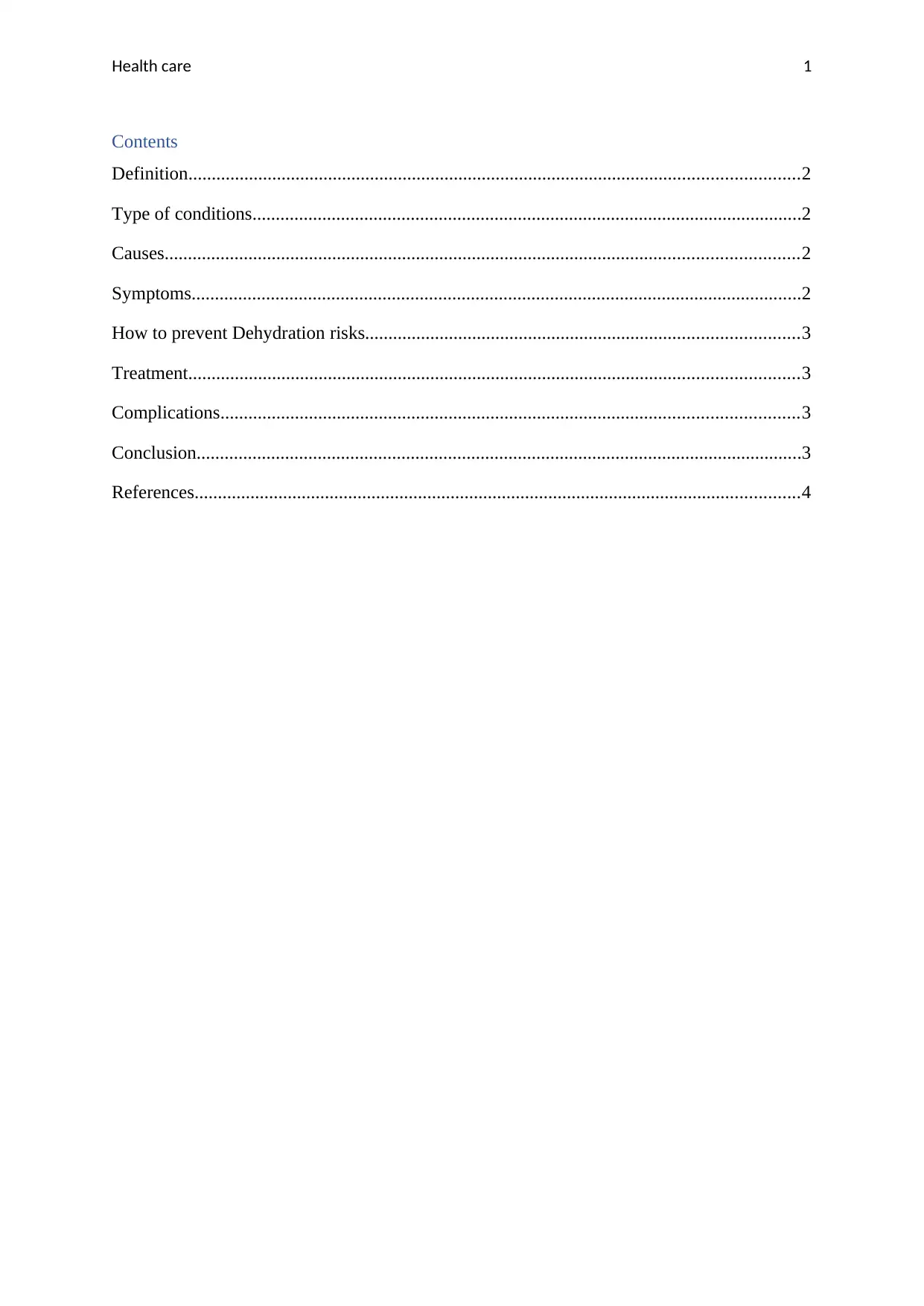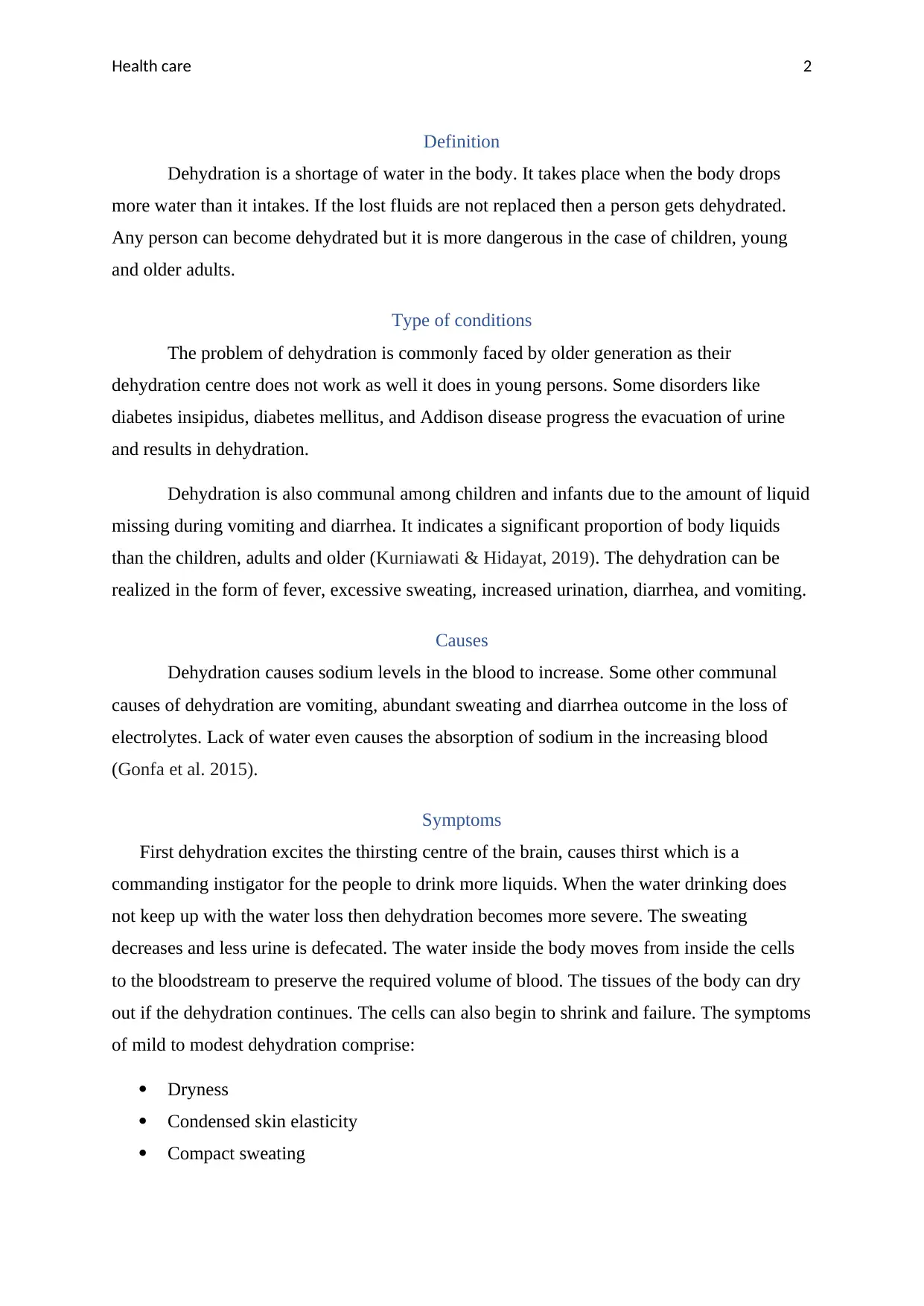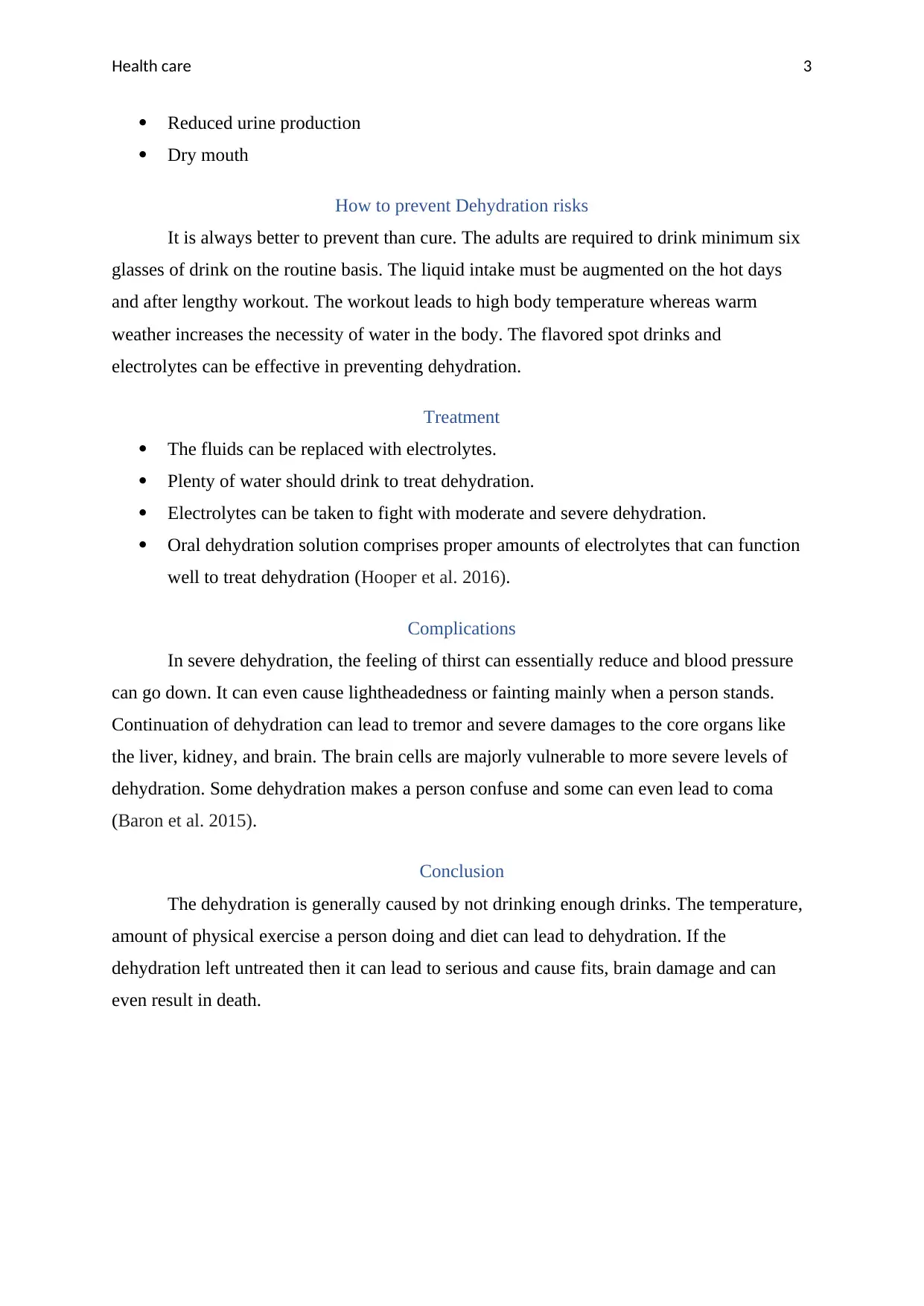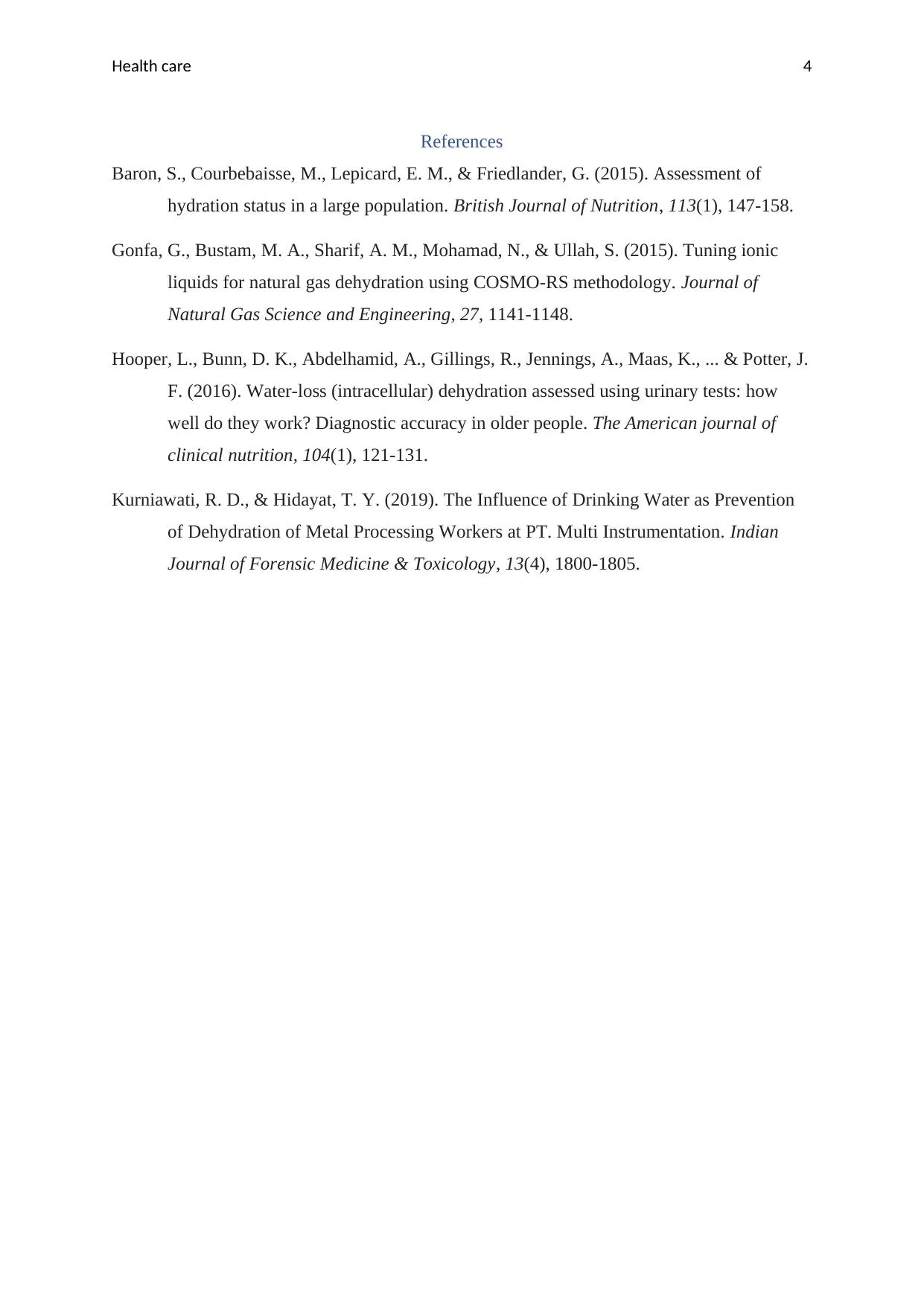Comprehensive Report on Dehydration: Causes, Risks, and Solutions
VerifiedAdded on 2022/09/06
|5
|858
|18
Report
AI Summary
This report provides a comprehensive overview of dehydration, a condition caused by a deficiency of water in the body. It defines dehydration, differentiating between its various types and outlining common causes such as vomiting, diarrhea, and excessive sweating, which lead to electrolyte loss. The report details the symptoms, ranging from mild thirst and reduced urine production to more severe manifestations like decreased skin elasticity and dry mouth. Prevention strategies include adequate fluid intake, especially during hot weather or after physical activity, and the use of electrolyte-rich drinks. The report also discusses treatment methods, such as oral rehydration solutions, and highlights potential complications like lightheadedness, organ damage, and, in severe cases, coma. The conclusion emphasizes the importance of timely intervention to avoid serious health consequences, referencing relevant studies and research findings.

Health care
Paraphrase This Document
Need a fresh take? Get an instant paraphrase of this document with our AI Paraphraser

Health care 1
Contents
Definition...................................................................................................................................2
Type of conditions......................................................................................................................2
Causes........................................................................................................................................2
Symptoms...................................................................................................................................2
How to prevent Dehydration risks.............................................................................................3
Treatment...................................................................................................................................3
Complications............................................................................................................................3
Conclusion..................................................................................................................................3
References..................................................................................................................................4
Contents
Definition...................................................................................................................................2
Type of conditions......................................................................................................................2
Causes........................................................................................................................................2
Symptoms...................................................................................................................................2
How to prevent Dehydration risks.............................................................................................3
Treatment...................................................................................................................................3
Complications............................................................................................................................3
Conclusion..................................................................................................................................3
References..................................................................................................................................4

Health care 2
Definition
Dehydration is a shortage of water in the body. It takes place when the body drops
more water than it intakes. If the lost fluids are not replaced then a person gets dehydrated.
Any person can become dehydrated but it is more dangerous in the case of children, young
and older adults.
Type of conditions
The problem of dehydration is commonly faced by older generation as their
dehydration centre does not work as well it does in young persons. Some disorders like
diabetes insipidus, diabetes mellitus, and Addison disease progress the evacuation of urine
and results in dehydration.
Dehydration is also communal among children and infants due to the amount of liquid
missing during vomiting and diarrhea. It indicates a significant proportion of body liquids
than the children, adults and older (Kurniawati & Hidayat, 2019). The dehydration can be
realized in the form of fever, excessive sweating, increased urination, diarrhea, and vomiting.
Causes
Dehydration causes sodium levels in the blood to increase. Some other communal
causes of dehydration are vomiting, abundant sweating and diarrhea outcome in the loss of
electrolytes. Lack of water even causes the absorption of sodium in the increasing blood
(Gonfa et al. 2015).
Symptoms
First dehydration excites the thirsting centre of the brain, causes thirst which is a
commanding instigator for the people to drink more liquids. When the water drinking does
not keep up with the water loss then dehydration becomes more severe. The sweating
decreases and less urine is defecated. The water inside the body moves from inside the cells
to the bloodstream to preserve the required volume of blood. The tissues of the body can dry
out if the dehydration continues. The cells can also begin to shrink and failure. The symptoms
of mild to modest dehydration comprise:
Dryness
Condensed skin elasticity
Compact sweating
Definition
Dehydration is a shortage of water in the body. It takes place when the body drops
more water than it intakes. If the lost fluids are not replaced then a person gets dehydrated.
Any person can become dehydrated but it is more dangerous in the case of children, young
and older adults.
Type of conditions
The problem of dehydration is commonly faced by older generation as their
dehydration centre does not work as well it does in young persons. Some disorders like
diabetes insipidus, diabetes mellitus, and Addison disease progress the evacuation of urine
and results in dehydration.
Dehydration is also communal among children and infants due to the amount of liquid
missing during vomiting and diarrhea. It indicates a significant proportion of body liquids
than the children, adults and older (Kurniawati & Hidayat, 2019). The dehydration can be
realized in the form of fever, excessive sweating, increased urination, diarrhea, and vomiting.
Causes
Dehydration causes sodium levels in the blood to increase. Some other communal
causes of dehydration are vomiting, abundant sweating and diarrhea outcome in the loss of
electrolytes. Lack of water even causes the absorption of sodium in the increasing blood
(Gonfa et al. 2015).
Symptoms
First dehydration excites the thirsting centre of the brain, causes thirst which is a
commanding instigator for the people to drink more liquids. When the water drinking does
not keep up with the water loss then dehydration becomes more severe. The sweating
decreases and less urine is defecated. The water inside the body moves from inside the cells
to the bloodstream to preserve the required volume of blood. The tissues of the body can dry
out if the dehydration continues. The cells can also begin to shrink and failure. The symptoms
of mild to modest dehydration comprise:
Dryness
Condensed skin elasticity
Compact sweating
⊘ This is a preview!⊘
Do you want full access?
Subscribe today to unlock all pages.

Trusted by 1+ million students worldwide

Health care 3
Reduced urine production
Dry mouth
How to prevent Dehydration risks
It is always better to prevent than cure. The adults are required to drink minimum six
glasses of drink on the routine basis. The liquid intake must be augmented on the hot days
and after lengthy workout. The workout leads to high body temperature whereas warm
weather increases the necessity of water in the body. The flavored spot drinks and
electrolytes can be effective in preventing dehydration.
Treatment
The fluids can be replaced with electrolytes.
Plenty of water should drink to treat dehydration.
Electrolytes can be taken to fight with moderate and severe dehydration.
Oral dehydration solution comprises proper amounts of electrolytes that can function
well to treat dehydration (Hooper et al. 2016).
Complications
In severe dehydration, the feeling of thirst can essentially reduce and blood pressure
can go down. It can even cause lightheadedness or fainting mainly when a person stands.
Continuation of dehydration can lead to tremor and severe damages to the core organs like
the liver, kidney, and brain. The brain cells are majorly vulnerable to more severe levels of
dehydration. Some dehydration makes a person confuse and some can even lead to coma
(Baron et al. 2015).
Conclusion
The dehydration is generally caused by not drinking enough drinks. The temperature,
amount of physical exercise a person doing and diet can lead to dehydration. If the
dehydration left untreated then it can lead to serious and cause fits, brain damage and can
even result in death.
Reduced urine production
Dry mouth
How to prevent Dehydration risks
It is always better to prevent than cure. The adults are required to drink minimum six
glasses of drink on the routine basis. The liquid intake must be augmented on the hot days
and after lengthy workout. The workout leads to high body temperature whereas warm
weather increases the necessity of water in the body. The flavored spot drinks and
electrolytes can be effective in preventing dehydration.
Treatment
The fluids can be replaced with electrolytes.
Plenty of water should drink to treat dehydration.
Electrolytes can be taken to fight with moderate and severe dehydration.
Oral dehydration solution comprises proper amounts of electrolytes that can function
well to treat dehydration (Hooper et al. 2016).
Complications
In severe dehydration, the feeling of thirst can essentially reduce and blood pressure
can go down. It can even cause lightheadedness or fainting mainly when a person stands.
Continuation of dehydration can lead to tremor and severe damages to the core organs like
the liver, kidney, and brain. The brain cells are majorly vulnerable to more severe levels of
dehydration. Some dehydration makes a person confuse and some can even lead to coma
(Baron et al. 2015).
Conclusion
The dehydration is generally caused by not drinking enough drinks. The temperature,
amount of physical exercise a person doing and diet can lead to dehydration. If the
dehydration left untreated then it can lead to serious and cause fits, brain damage and can
even result in death.
Paraphrase This Document
Need a fresh take? Get an instant paraphrase of this document with our AI Paraphraser

Health care 4
References
Baron, S., Courbebaisse, M., Lepicard, E. M., & Friedlander, G. (2015). Assessment of
hydration status in a large population. British Journal of Nutrition, 113(1), 147-158.
Gonfa, G., Bustam, M. A., Sharif, A. M., Mohamad, N., & Ullah, S. (2015). Tuning ionic
liquids for natural gas dehydration using COSMO-RS methodology. Journal of
Natural Gas Science and Engineering, 27, 1141-1148.
Hooper, L., Bunn, D. K., Abdelhamid, A., Gillings, R., Jennings, A., Maas, K., ... & Potter, J.
F. (2016). Water-loss (intracellular) dehydration assessed using urinary tests: how
well do they work? Diagnostic accuracy in older people. The American journal of
clinical nutrition, 104(1), 121-131.
Kurniawati, R. D., & Hidayat, T. Y. (2019). The Influence of Drinking Water as Prevention
of Dehydration of Metal Processing Workers at PT. Multi Instrumentation. Indian
Journal of Forensic Medicine & Toxicology, 13(4), 1800-1805.
References
Baron, S., Courbebaisse, M., Lepicard, E. M., & Friedlander, G. (2015). Assessment of
hydration status in a large population. British Journal of Nutrition, 113(1), 147-158.
Gonfa, G., Bustam, M. A., Sharif, A. M., Mohamad, N., & Ullah, S. (2015). Tuning ionic
liquids for natural gas dehydration using COSMO-RS methodology. Journal of
Natural Gas Science and Engineering, 27, 1141-1148.
Hooper, L., Bunn, D. K., Abdelhamid, A., Gillings, R., Jennings, A., Maas, K., ... & Potter, J.
F. (2016). Water-loss (intracellular) dehydration assessed using urinary tests: how
well do they work? Diagnostic accuracy in older people. The American journal of
clinical nutrition, 104(1), 121-131.
Kurniawati, R. D., & Hidayat, T. Y. (2019). The Influence of Drinking Water as Prevention
of Dehydration of Metal Processing Workers at PT. Multi Instrumentation. Indian
Journal of Forensic Medicine & Toxicology, 13(4), 1800-1805.
1 out of 5
Related Documents
Your All-in-One AI-Powered Toolkit for Academic Success.
+13062052269
info@desklib.com
Available 24*7 on WhatsApp / Email
![[object Object]](/_next/static/media/star-bottom.7253800d.svg)
Unlock your academic potential
Copyright © 2020–2025 A2Z Services. All Rights Reserved. Developed and managed by ZUCOL.



